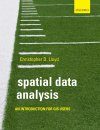![Spatial Data Analysis Spatial Data Analysis]()
Click to have a closer look
About this book
Contents
Customer reviews
Related titles
About this book
What is the shortest route between one point and another in a road network? Where is the incidence of disease the highest? How does rainfall correlate with altitude? How does the concentration of a pollutant vary in space, and where do high concentrations correlate with densely populated areas? Geographical or spatial data play a vital role in many parts of daily life. We are dependent on information about where things are located and about the attributes of those things, either directly, as in the use of a map for navigating around a city, or indirectly, where we use resources like water or gas.
Making use of spatial data requires a whole set of approaches to extract information from those data and make them useful. Underpinning these approaches is the analysis of data. This book introduces key principles about spatial data and provides guidance on methods for their exploration; it provides a set of key ideas or frameworks that will give the reader knowledge of the kinds of problems that can be tackled using the tools that are widely available for the analysis of spatial data.
The approach is gradual and systematic; the initial focus is on themes that follow through the rest of the book. These key ideas are introduced, illustrated and restated to ensure that readers develop a clear understanding of them. Beyond careful explanations, a clear understanding is fostered still further by numerous worked examples and case studies. In short, the stress is on first principles and reinforcement of key ideas throughout - on education rather than simply training, based on the conviction that users of spatial data analysis tools should know something about how the approaches work rather than simply how to apply them.
Contents
Chapter 1. Introduction
Chapter 2. Key concepts 1: GIS
Chapter 3. Key concepts 2: statistics
Chapter 4. Key concepts 3: spatial data analysis
Chapter 5. Combining data layers
Chapter 6. Network analysis
Chapter 7. Exploring spatial point patterns
Chapter 8. Exploring spatial patterning in data values
Chapter 9. Spatial interpolation
Chapter 10. Analysis of grids and surfaces
Chapter 11. Summary
References
Appendix A. Matrix multiplication
Appendix B. The exponential function
Appendix C. The inverse tangent
Appendix D. Line Intersection
Appendix E. Ordinary least squares
Appendix F. Ordinary kriging system
Appendix G. Problems and solutions
Customer Reviews



































